This post, third in the series about bicycle saddles, explains what kinds of saddle shapes there are and which to choose according to one’s needs and riding style. Previous two posts explain bicycle saddle material and padding. While the next post will explain sizing (width primarily).
If you have any questions (or additions and corrections), please use the BikeGremlin forum:
www.bikegremlin.net
Table Of Contents (T.O.C.)
Saddle shapes differ in the following attributes:
- Waviness from nose to the back
1.1. Flat saddles
1.2. Waved saddles
1.3. Moderately waved saddles - Curvature from the sides towards the middle
2.1. (Almost completely) flat saddles
2.2. Curved saddles - Pear vs T shaped profile (looking from the top)
- Cutout in the middle
4.1. Saddle with a cutout in the middle
4.2. Full (solid) saddles
4.3. Saddle with a relief channel in the middle - Bicycle saddle model recommendations
1. Waviness from nose to the back
By this criteria, there are three types of saddles: flat, waved and moderately waved.
1.1. Flat saddles
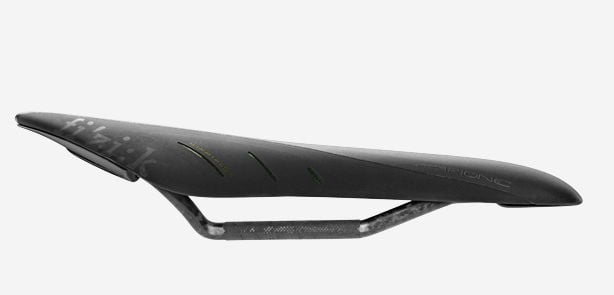
Flat saddle
Source: www.fizik.com
Flat saddles are practically completely flat – i.e. there are no raised, nor lowered areas in along the front to back axis.
Such saddles are good for upright riding posture, as well as for highly flexible riders in more leaned riding posture, like shown in pictures 2 and 3.
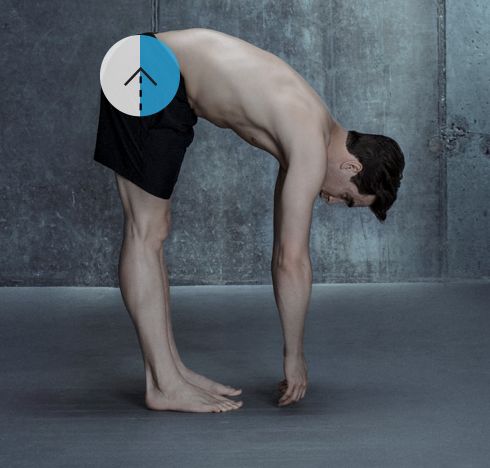
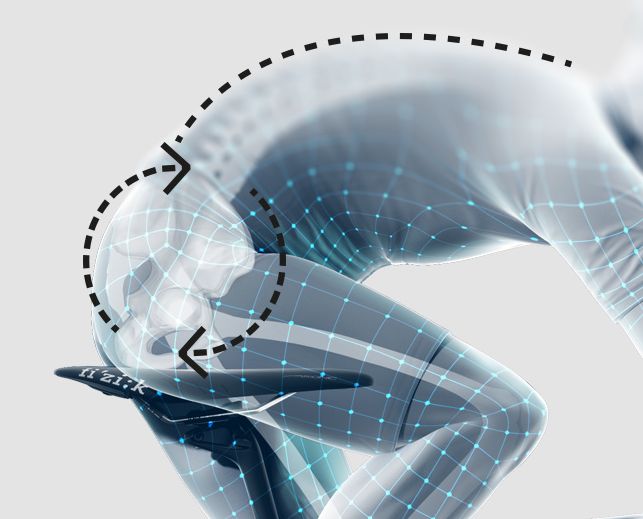
Advantage of a flat saddle is the ability to easily alter saddle position – sliding from front to back and reverse. Some riders like this and find that position changes provide more comfort, while the ease of position changes on a flat saddle is good for fast riding – with moving more forward when leaning more, and moving back when riding more upright.
This can be particularly useful on road bikes, with multiple hand positions on the (drop) bars. Flat saddles can also be good bicycles ridden more upright (rider flexibility isn’t important there). Still, some riders, even flexible ones, don’t like the ease of sliding back and forth and prefer a saddle that keeps them more stabily in place. There come the other shape – waved saddles.
1.2. Waved saddles
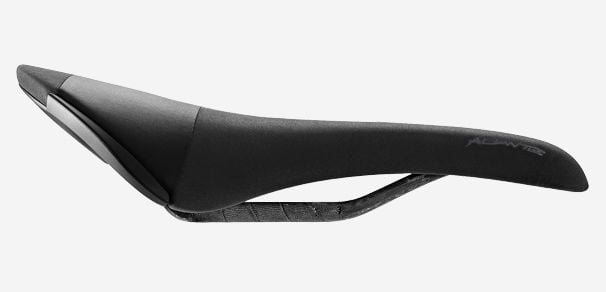
Waved saddle
Source: www.fizik.com
Waved saddles have raised rear part, that slopes down towards the middle, then flattening along the front part of the saddle.
Such saddles are preffered by not very flexible riders who ride in a leaned forward position. They also suit riders who don’t like to change sitting position (back and forth), but prefer a saddle that holds them more stably in (one) place.
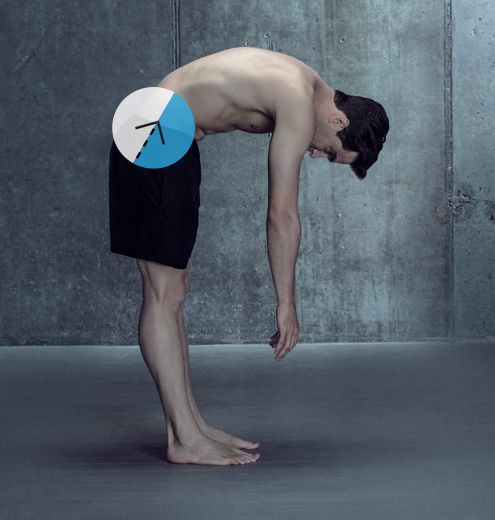
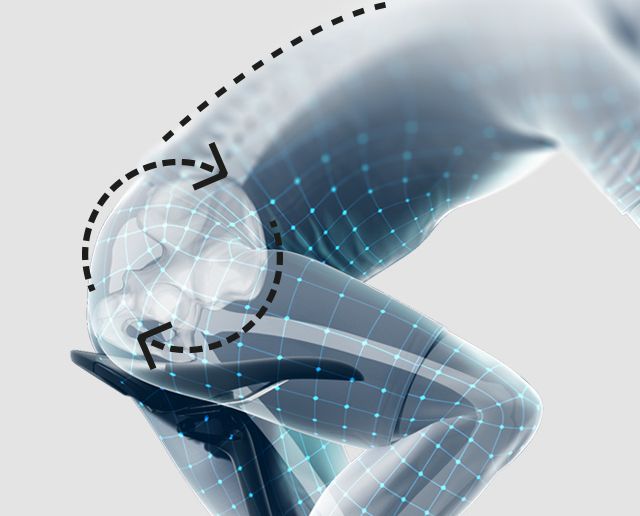
Source: www.fizik.com
As can be seen from picture 6, when a not very flexible rider leans forward, the pelvis turns as well. This, for the pubic area, produces the effect similar to tilting the saddle nose higher up by 10 or more degrees. A flat saddle would be more likely to cause pubic area (sof tissue) discomfort. That is why such riders often find waved saddles more comfortable.
1.3. Moderately waved saddles
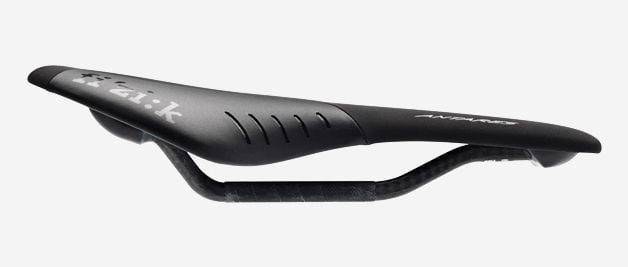
Moderately flat / waved saddle
Source: www.fizik.com
Moderately waved saddles are not completely flat, but the curvature is much less accentuated than with waved saddles. By all the pros and cons they lie between the flat and the waved saddles. So they are most likely to suit moderately flexible riders in a leaned position, or bicycles with a semi-upright riding position.
Having said all this, there is also a variation in the average sit bone shape of men and women. Women tend to have wider sit bones, with a less raised pubic arch (picture 8).
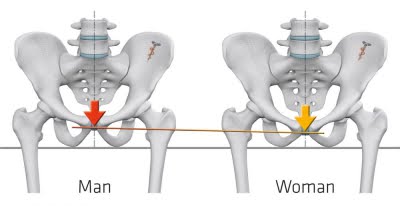
Male and female pubic bone “height”
Source: www.sq-lab.com
For this reason, a woman of the same flexibility and riding posture, would effectively load the saddle similarly to a man that is bent forward more – and will more likely require a more waved saddle.
2. Curvature from the sides towards the middle
By this criteria saddles can be roughly divided into two groups: (more, or less) flat and (very) curved. With numerous variations between the two extremes.
2.1. (Almost completely) flat saddles
These saddles are flat, i.e. sides of the saddle are at (almost) the same height as the middle of the saddle.
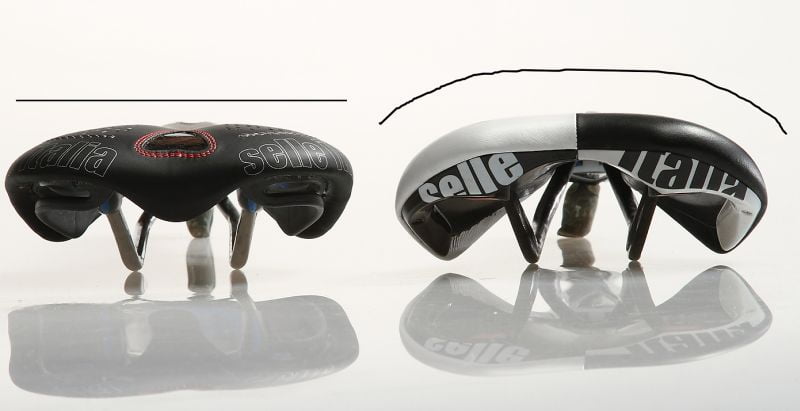
Flat (left) and curved (right) saddle
Source: www.randorichard.com
Flat saddles provide less pressure in the pubic area, but allow more left to right sliding of the body, compared to the curved saddles.
2.2. Curved saddles
Curved saddles keep the body more centered, but can cause more pubic area pressure/discomfort, as it is shown in the picture 10 below.

Curved saddle (left) and flat saddle (right)
Source: www.cervelo.com
3. Pear vs T shaped profile (looking from the top)
Saddle shape, looking from the top, can be pear shaped (with a more gradual transit from the wide rear area, to the narrower front area), or T letter shaped (with a more abrupt narrowing towards the front part). The difference is shown in the pictrue 11, with a pear shaped white Selle San Marco Concor saddle picture layered over a T shaped grey Selle Italia Flite saddle picture.
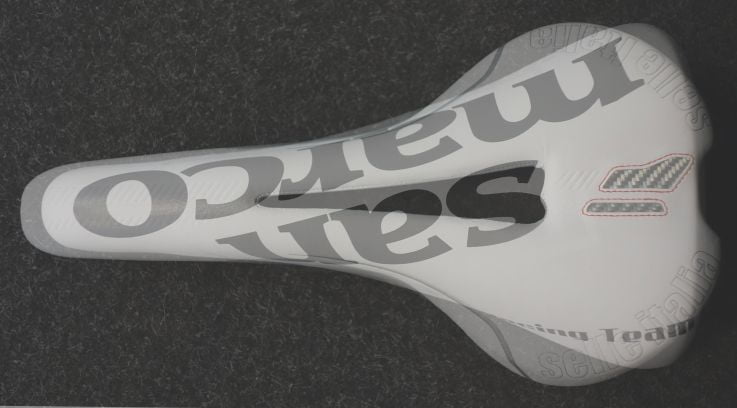
A white pear shaped saddle layered over a grey T shaped saddle
Source: www.fitworkscycling.com
T shaped saddles often provide more comfort in the area where thighs rub (while pedalling) the saddle. Pear shaped saddles are prefered by riders who like to change fore and aft sitting position while riding. They generally provide more support when the body is moved forward in the saddle.
Here it is important to mention that, depending on the fore-aft sitting position (most often) used while riding, the saddle width varies depending on the saddle’s T or pear shape. For example, comparing two saddles of the same (maximal) width, a T shaped saddle will be wider in the rear part of the saddle, but it will be narrower in the middle part of the saddle, than a pear shaped saddle (of the same maximal width). And vice-versa.
Body should lean with sit bones on the saddle, while thighs should not chafe the saddle sides, only the “front” sides of the saddle (picture 12).
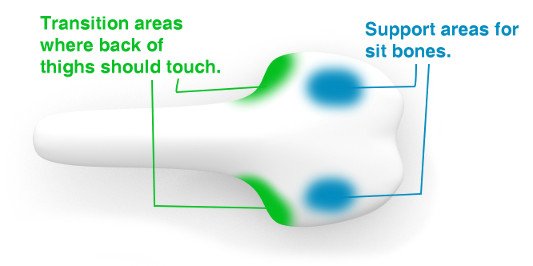
Saddle load (contact points)
Source: www.kontactbike.com
4. Cutout in the middle
There are saddles with a cutout in the middle, full saddles (with no cutout) and saddles with a “relief channel” (but without a cutout).
4.1. Saddle with a cutout in the middle
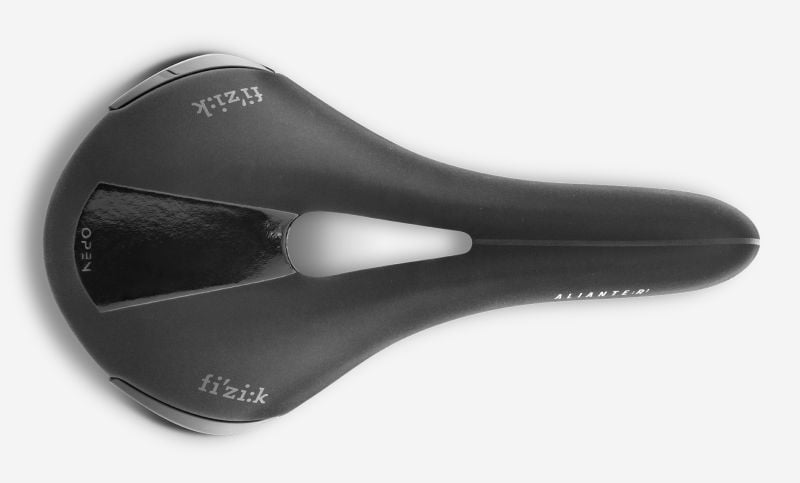
A saddle with a cutout in the middle
Source: www.fizik.com
Cutout in the middle relieves pubic (soft tissue) area in the greatest part, and provides ventilation, which is good in the summer and not so good in the winter. 🙂
Depending on the sharpness of the saddle curve around the cutout, some riders find the edge of the cutout to cause discomfort.
4.2. Full (solid) saddles
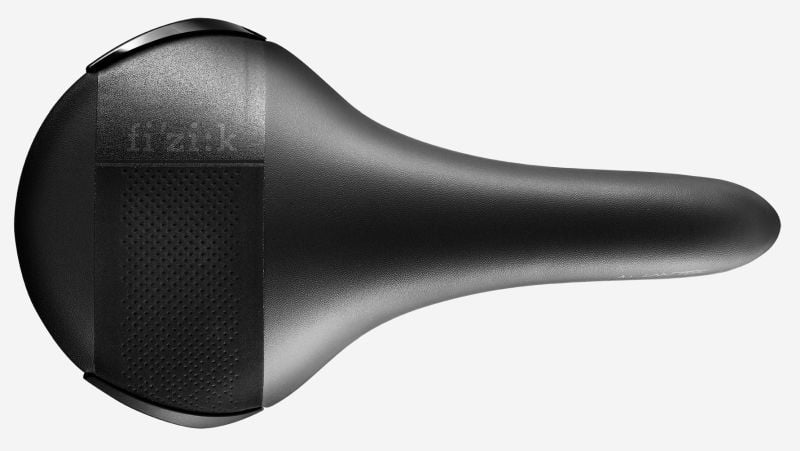
Full (solid) saddle
Source: www.fizik.com
These saddles are completely full, without any cutouts or indentations in the middle. They provide the most support and comfort, but the least pubic area relief.
A good way for a rider to deterimne whether they need a saddle cutout, or could use a full saddle is the following:
- Sit on a hard wooden (or concrete) bench, so that the knees are bent at about 90 degrees, and the back is straight.
- Keeping the back straight, bend forward (at the waist) untill the elbows can rest on the knees.
- Stay in that position for 5 minutes (best to measure).
If there’s no discomfort/pressure in the pubic area, then the “test subject” is fit for a full (solid) saddle. If there is pressure/discomfort, then a saddle with a cutout (or a relief channel) is a better choice.
4.3. Saddle with a relief channel in the middle
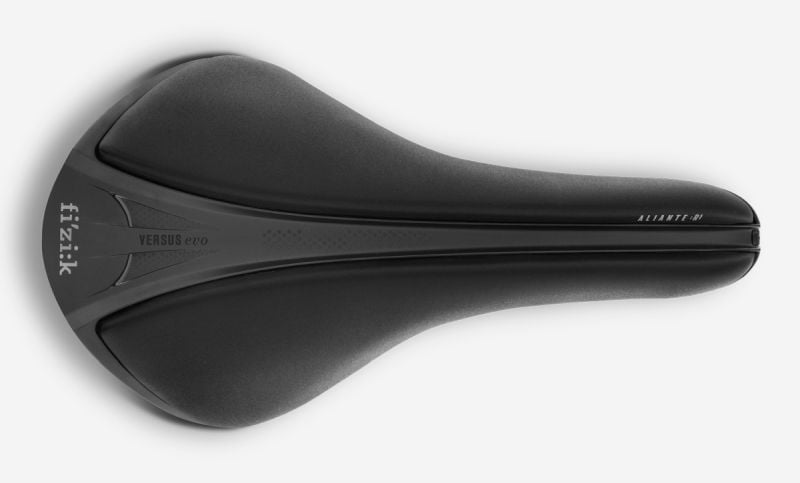
Saddle with a relief channel
Source: www.fizik.com
By all the pros and cons somewhere in between a full (solid) saddle and a saddle with a cutout.
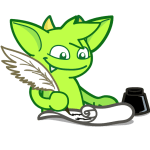
When it comes to choosing the righ saddle, there are a lot of exceptions to the rules. For example – some flexible riders prefer waved saddles. The only valid measure is to try for oneself. This series of saddle posts is ment to serve more as a guideline – so one can know where to start when choosing and trying a new saddle, or, if the current saddle causes discomfort – to know in which “direction” to look for a change. I.e. what effect is a different saddle shape most likely to make.
A very important atribute – saddle width, is explained in a separate post: Optimal bicycle saddle width, but first sit bones need to be measured according to these instructions – Measuring sit bone width.
5. Bicycle saddle model recommendations
Before buying, I would advise reading all 5 short articles in this series (this is the 3rd one):
- Bicycle saddle fit [01] Materials they are made of
- Bicycle saddle fit [02] Saddle padding
- Bicycle saddle fit [03] Saddle shape
- Bicycle saddle fit [04] Measuring sit bone width
- Bicycle saddle fit [05] Optimal saddle width
- My bicycle saddle is uncomfortable, what should I do?
If a concrete recommendation can help you, these saddle models have served me very well over the years (using Amazon affiliate links):
An excellent MTB saddle is Selle Royal model Suez.
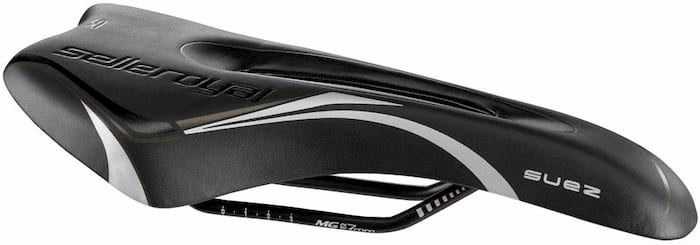
A rather athletic saddle, but its padding is not too hard, so they are comfortable even without the use of padded cycling shorts (bibs) – Amazon affiliate link. It is cut out in the middle, to eliminate any pressure on the “sensitive parts” of both men and women (for the latter claim I’m relying on the feedback I got from female cyclists who have used this model – just look at my pronouns 🙂 ).
An excellent saddle for city bicycles (and all the others with a more upright sitting position), is Brooks model Flyer.
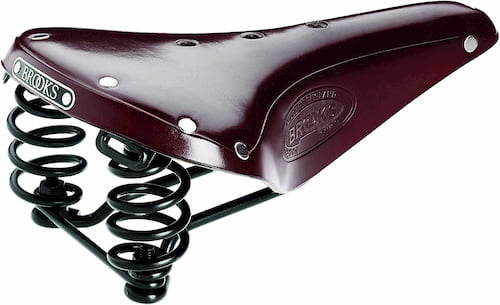
Brooks Flyer is a bit heavier (steel frame, with leather). But thanks to its shape, and the springs at the rear, it is very comfortable, even on extremely long rides (cyclo-touring etc.). Springs are very hard, so you won’t be bouncing when pedalling, but they will absorb any harsh road shocks (bumps, potholes). The leather is great for the summer, but can feel a bit colder in the winter (compared to synthetic materials), and it can get soaked if left in the rain. So I’d avoid this for very wet, or cold climates.
Finally, a road bicycle recommendation – Fizik Antares R3 Open K:IUM Regular black
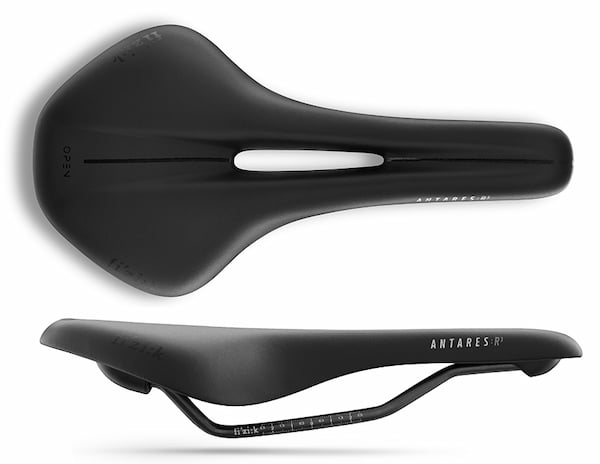
Help BikeGremlin
stay online & independent
This website is educational, free, objective, and not commercial
(sponsors don’t enjoy paying if you mention all the product downsides that you notice 🙂 ).
How much does a WordPress website cost?
If you find this site to be good and helpful,
and if $5 per month is what you can afford to set aside,
please consider supporting my work with a Patreon donation:
If you have any questions (or additions and corrections), please use the BikeGremlin forum:
www.bikegremlin.net

This is the very best, holistic guide to choosing a saddle I have ever seen. I need to re read to dissect again, but from what I have found out myself through trial and error, this article has wrapped it up nicely.
Thanks. I have been cycling for almost 4 decades now. However, it is still based mostly on my (one man’s) experience, so any suggestions, additions and especially corrections are more than welcome. 🙂
Thank you, I wish I had found this excellent text before.
Thank you for this article, it was very informative. Hoping you can help me out in finding a specific type of saddle. I find that I get some rubbing/friction discomfort where my femur meets the pubic bone on my current saddle. I have tried anti-friction balm, but I suspect it is the saddle. Interestingly, I only get the rubbing/friction on my left side.
Can you suggest a T-shaped saddle that offers a generous cutout in that area? Bonus points if it is tan/brown colored (but probably asking too much at this point!).
Thanks!
Scott
Hi Scott,
A saddle that works for me (i.e. what I use) is:
Fizik Antares R3 Open K:IUM – the Regular variant which is 140 mm wide (Bike-Discount shop link).
I plan to order two more next month, because manufacturers always change models, shapes, and padding – it’s that well-fitting for me so I plan to “stock up.” But, as is the case with saddles, the choice is extremely subjective, so it might not work for you.
For a more upright riding position, I suppose that the “Large” version, which is 152 mm wide, might be a better fit – and, vice-versa, for a more prone position, it could be uncomfortable and cause more thigh chafing.
its not easy to choose a good saddle,probably the hardest thing to get correct on your bike,i tried saddles with cutouts and they were not for me,so then i tried a softer gel type saddle,was not happy with that one either in the end i found one old school saddle called velo and that one was not to firm,not too soft,just right,it can also be more comfortable if you run the saddle in a level postion,not pointing downwards at the front,another good option is to get padded bike shorts,or you could even make your own padded bike shorts,the firmer type saddles actually work better for me and ones that are not to wide as the wider ones rub too much on the inside thigh,the pro riders ride on very firm saddles with padded bike shorts and very skinny saddles
some of those high end racing saddles are very nice,they dont look like they would be comfortable due to the skinny size and low padding but they are very nice saddles to ride on